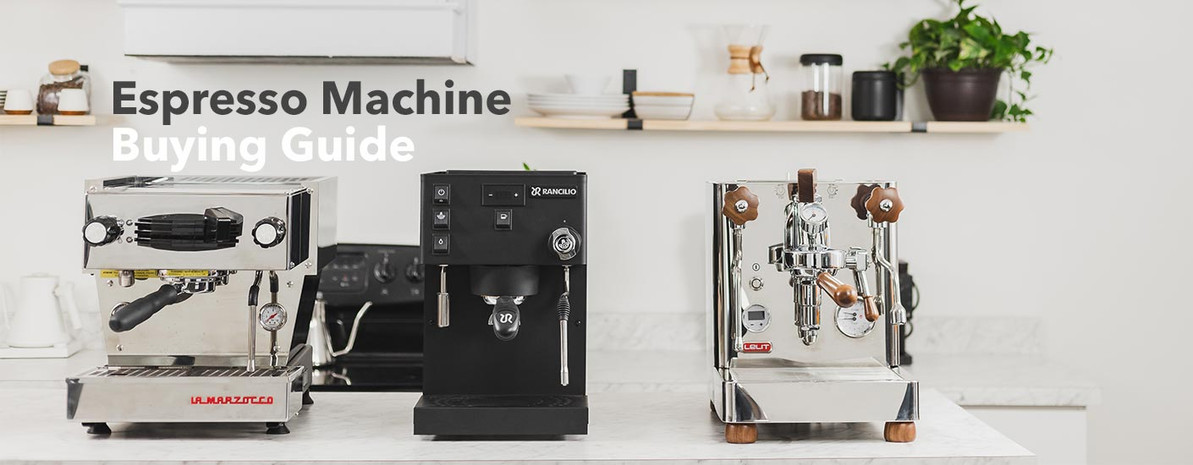Home Espresso Machines Buying Guide
Armed with a notebook of lines and measurements, a fuzzy approximation of your kitchen and counter space, you have come here in search of the perfect machine, thinking it will emerge from the masses with obvious aplomb and dimensions appropriate. The problem is that there are so many variables to consider when choosing an espresso machine, including (but certainly not limited to) budget, boilers, features, size, and aesthetics, and so many machines on the market, that the best choice may not always be so obvious. In fact, the process of choosing a new espresso machine might be maddening.
You have come to the right place. We pride ourselves on curating a manageable selection of home espresso machines (in addition to all sorts of other coffee-centric goodies), all of which we have used and endorse, and on identifying the right match for every customer. As such, we have created this comprehensive espresso machine buying guide.
Part One:Home Espresso Machine Highlights
If you are at the beginning of your buying journey, you may not know the lay of the land. In this section, we have compiled a list of machines, organized by price (least to most), and identified several desirable features for each one. We have also included a list of what we are calling “considerations.” Taken together, the features and considerations should add up to an honest assessment of each machine’s strengths and weaknesses in the home espresso landscape and, we hope, will help you to decide which one is right for you.
Flair Pro 2

The Flair is the perfect choice for:
- Traveling baristas
- Total control

Features
- Relatively inexpensive. The most affordable espresso machine in our catalogue.
- Compact footprint. Folds into a carrying case.
- Pressure gauge.
- Silicone lever grip. Comfortable to use.
- Contemporary design.
Considerations
- All manual. Takes some elbow grease.
- No boiler. Requires hot water from a kettle.
- Unconventional size for filter holder, basket, and portafilter. 46mm.
- Imperfect weight distribution. Machine unsteady during use.
- Some plastic parts.
Cafelat Robot

The Robot is the perfect choice for:
- Vintage baristas
- Total control

Features
- Relatively inexpensive.
- Premium materials.
- 58mm grouphead, basket, tamper.
- Temperature stability.
- Accessories available.
- Color options.
Considerations
- All manual. Takes some elbow grease.
- No boiler. Requires hot water from a kettle.
- Additional cost for pressure gauge model.
- Metal hands for levers. Uncomfortable to hold down.
- Not for travel. Cannot be folded and packed away.
Lelit Anna
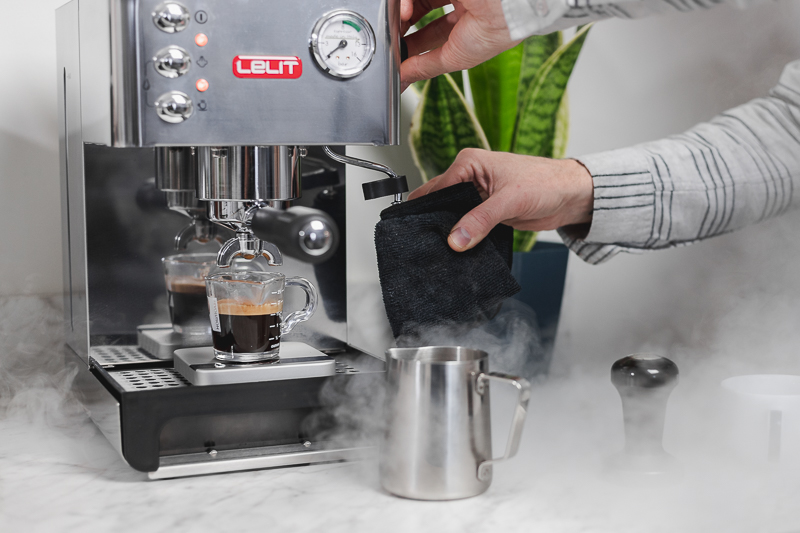
The Anna is the perfect choice for:
- Baristas on a budget
- Small spaces

Features
- Relatively inexpensive. The most affordable electric machine in our catalog.
- Compact footprint. 13” x 10” x 9”; 16 lbs.
- Dual-purpose wand. Dispense hot water or steam milk with the wand.
- Manometer (pressure gauge).
- 3-way solenoid valve. Depressurizes the chamber and removes excess water after shot.
Considerations
- Single boiler. Cannot brew and steam at the same time.
- Small boiler. 250ml / 8oz.
- 57mm group. Customization options (for portafilters, baskets, and tampers) limited.
- No PID controller. Temperature subject to fluctuations.
Rancilio Silvia M

The Silvia M is the perfect choice for:
- Serious yet patient baristas
- Learning with others

Features
- Relatively inexpensive.
- Compact footprint. 14” x 11” x 9”; 30 lbs.
- Tried and True. Been around since the 1990s.
- Commercial parts. 58mm brass grouphead; fully articulating steam wand.
- 3-way solenoid valve. Depressurizes the chamber and removes excess water.
Considerations
- Single boiler. Cannot brew and steam at the same time.
- Small boiler. 300ml / ~10oz.
- No PID controller. Temperature subject to fluctuations.
- No manometer (pressure gauge).
La Pavoni EPC-8
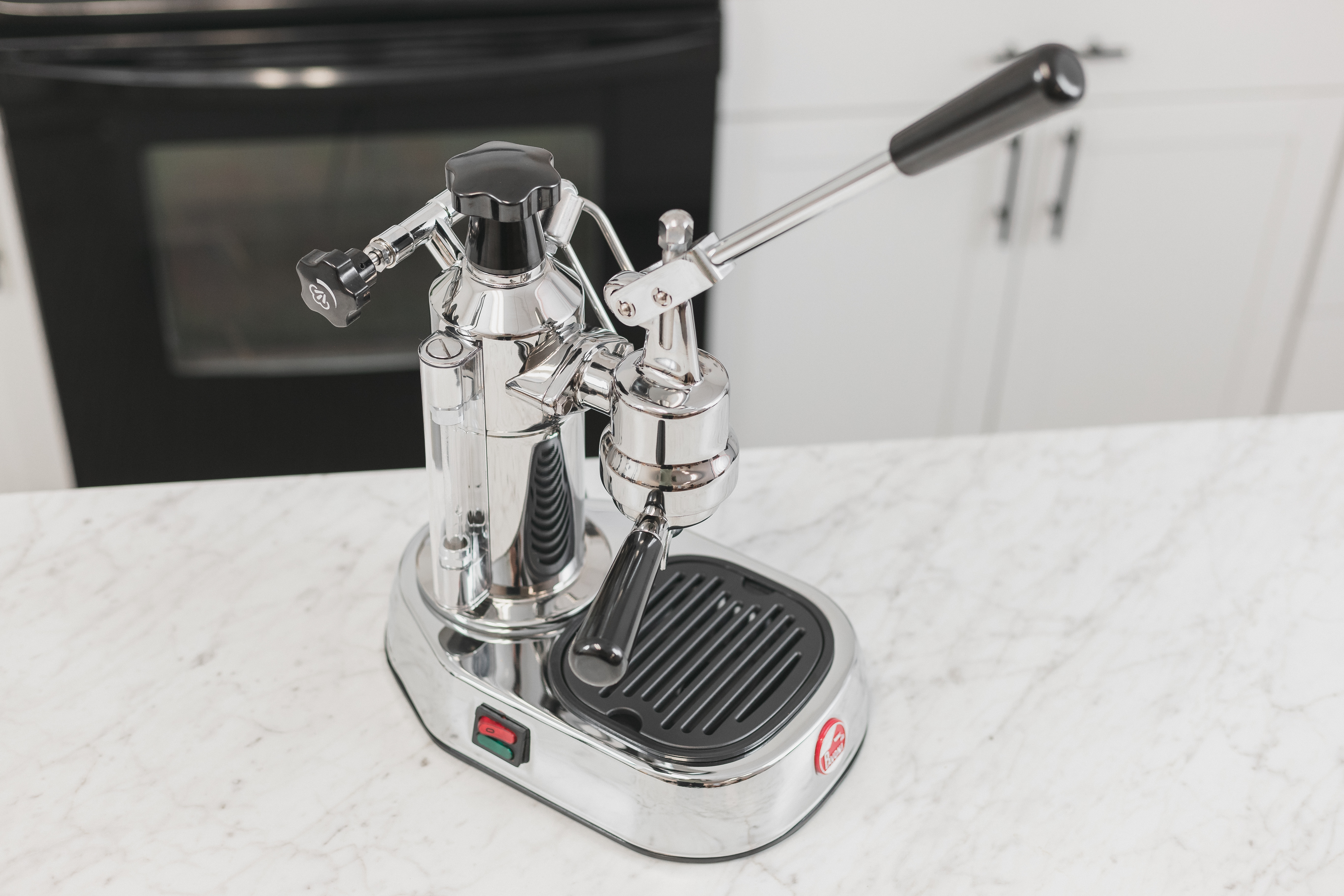
The EPC-8 is the perfect choice for:
- Hands-on baristas
- Small spaces

Features
- Compact footprint. 12” x 11.5” x 8”; 11 lbs.
- The classic lever machine. Created in the 1950s.
- Large boiler. 800ml.
- Pressure profiling. Customize pre-infusion and extraction.
- Lag-less. No wait between brewing and steaming.
Considerations
- Single boiler. Cannot brew and steam at the same time.
- Volatile temperature. Requires flushing routine.
- Hot. Boiler and grouphead are exposed and can cause burns.
- 51mm group, portafilter, and basket. Limited customization options.
- Small basket. Maximum 17g.
Rancilio Silvia Pro
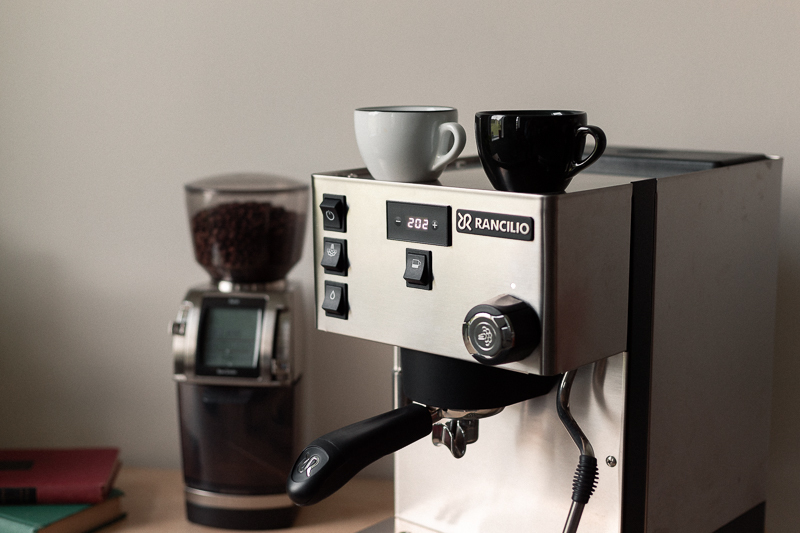
The Silvia Pro is the perfect choice for:
- Meticulous baristas
- Temperature stability

Features
- Dual boilers. The most affordable dual-boiler machine in our catalog.
- Powerful steam wand. Delivers dry steam through 4-hole tip.
- Dual PID controllers. Remarkably stable brew and steam boiler temperatures.
- Digital menu. Program temperatures, wake-up mode, etc. from display; see shot timer when brewing.
- Adjustable drip tray.
- Color options (additional cost).
Considerations
- Semi-automatic. Shots not programmable by volume or time.
- Shallow drip tray.
- Cheap portafilter. Plastic handle, nickel head.
Lelit Bianca
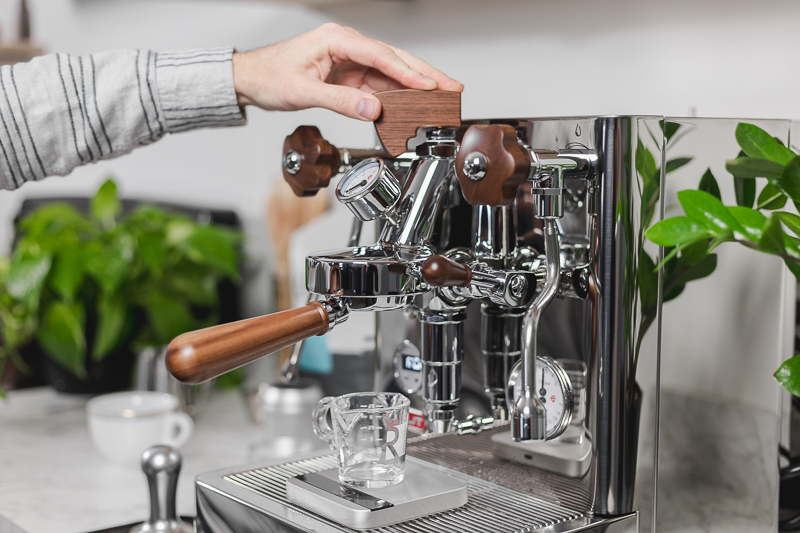
The Lelit Bianca is the perfect choice for:
- Mad scientists
- Flow control

Features
- Dual boilers.
- Flow control. Manipulate water flow during shots with paddle.
- Grouphead manometer. See pressure at grouphead in real time.
- Lelit control center. Program pre-infusion, temperatures, etc.
- PID controllers.
- Repositionable water tank. Place on either side or remove completely when plumbing in.
- Cool touch steam wand.
- Walnut highlights. Knobs, portafilter, paddle, and feet.
- Premium accessories. Comes with bottomless portafilter, precision tamper, 4- and 2-hole steam tip, etc.
Considerations
- Semi-automatic. Shots not programmable by volume or time. Lever operation.
- E-61 design. Most stable temperature with flushing routine.
El Rocio Zarre

The El Rocio Zarre is the perfect choice for:
- Mad scientists
- Pressure profiling

Features
- Dual boilers.
- Pressure profiling. External controller with dial.
- Use pressure profiling dial or program shots by time.
- Heated grouphead. Temperature stable from boiler to brew.
- PID temperature controllers. Includes additional one for grouphead heater.
- Plumb in or reservoir options.
- Custom finishes. Walnut, maple, or black panels, portafilters, and knobs.
Considerations
- External controller. All parameters set and pressure manipulated through control box.
- Classic steam wand. Hot to the touch.
La Marzocco Linea Mini

The Linea Mini is the perfect choice for:
- Professional home baristas
- Catering operations

Features
- Dual boilers.
- Classic La Marzocco design. Modeled after the original Linea.
- Integrated group. Combined brew boiler and grouphead for temperature stability.
- PID temperature controller.
- Internal rotary pump.
- Extra large steam boiler. 3.5L. Delivers commercial-power dry steam.
- Connected machine. Adjust settings in the app.
- Plumb in or reservoir options.
- Color options.
Considerations
- Semi-automatic. On/off brew operation with paddle. No volumetric programming.
- PID wheel. Temperature adjusted manually.
- Extra small brew boiler. ~6oz.
- Water reservoir behind drip tray..
- Heavy. 71 lbs.
Victoria Arduino Eagle One Prima
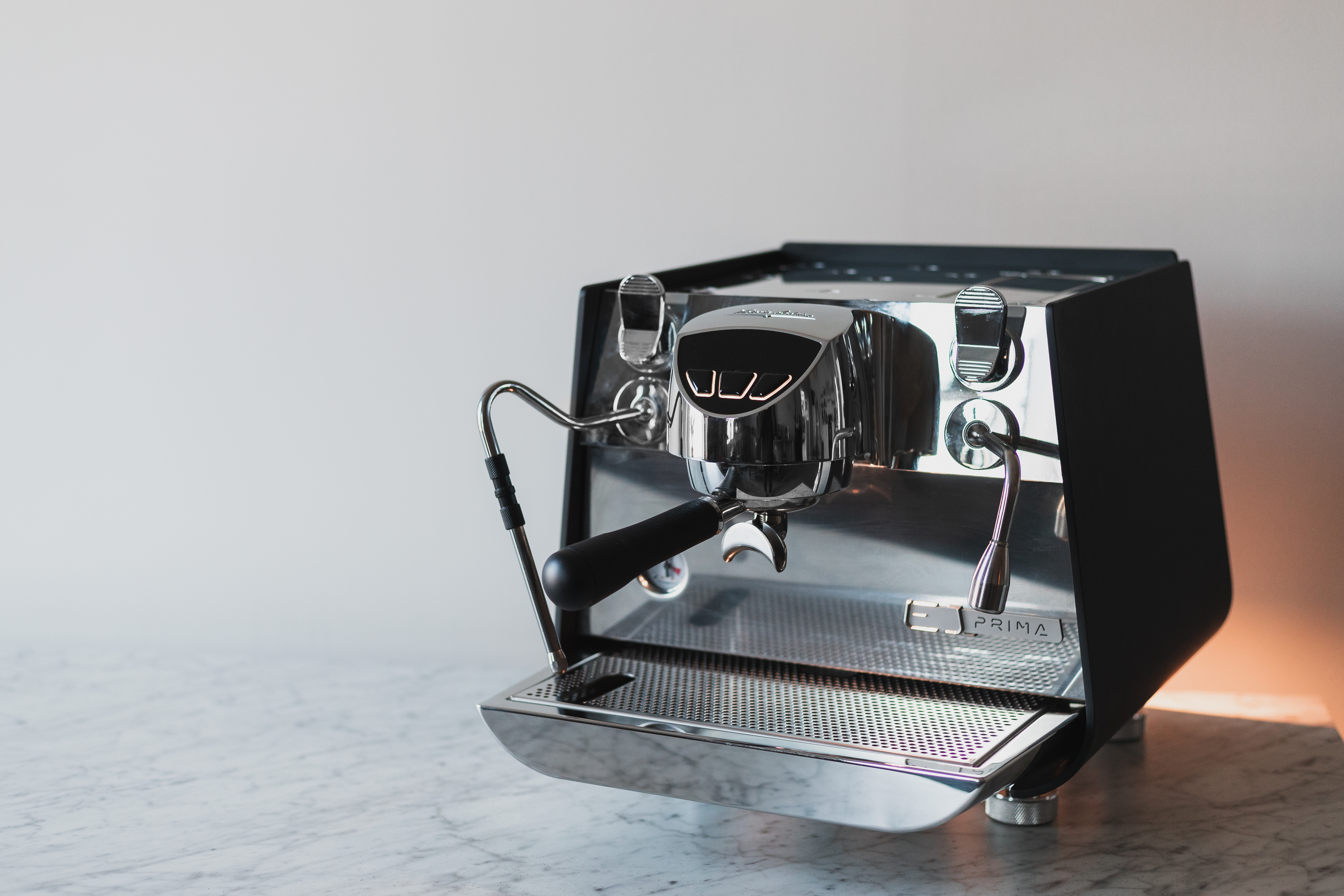
The Eagle One Prima is the perfect choice for:
- Professional home baristas
- Mobile cafés

Features
- Dual boilers.
- 100% digital. Adjust parameters in the app.
- Volumetric. Program up to two shots by water volume.
- Energy efficient. Victoria Arduino’s New Engine Optimization technology.
- Internal rotary pump.
- PID temperature controller.
- Auto purge. Quick flush when the portafilter is removed.
- Cool touch steam wand.
- Plumb in or reservoir options.
- Color options.
Considerations
- New product. Released in 2020. Feedback minimal.
- New app. Bugs, especially for iPhones, being worked out.
- Extra small boilers. 4.75oz. brew boiler and 1.5L steam boiler.
- Small water reservoir.
- Ghost display. Temperature visible only when heating.
Part Two: Deciding Factors in Choosing an Espresso Machine
One of the lessons we have learned over the years is that a customer’s decision sometimes comes down to one piece of the puzzle, be it budget, counter space, even looks, or even automation, which is why we have compiled a guide based on major factors that may weigh more heavily in your decision. Choose from the list below and let us guide you toward some options.
Price
Price is a good place to start, especially if this is your first machine or an upgrade from a popular thingamajig that pushes lukewarm water through a hole-punched plastic filter. For under$500, you can get a professional-grade manual lever machine (Robot or Flair) and for a little more you can get Lelit’s entry-level Anna ($569*). For a couple hundred dollars more, you can get Rancilio’s stalwart Silvia ($830*) or a beloved mixture of old and new in the La Pavoni Europiccola ($989*) electric lever espresso machine. If you choose a Robot or Flair and milk is a must, throw in a Bellman stovetop steamer for an extra $115*.
*These are the prices as of August 2022. Check the listings for updates.

Automation
Premium home machines run the range from top-shelf volumetrics all the way to manual lever machines. If you want a little leisure, consider the La Marzocco GS3, Victoria Arduino Eagle One Prima, or El Rocio Zarre, all of which can be programmed according to volume/time, or Rancilio's Silvia or Silvia Pro, both of which require only the push of a start and stop button. We recommend a drip-tray scale like the Acaia Lunar or Pro Scale XC2000 to help you dial in.

Steam
Quality steam is possible with all of our electric espresso machines, including those with a single boiler, but it is above $1,500 where the steam starts to get very serious. Such dual-boiler models as the Silvia Pro from Rancilio, Bianca from Lelit, and Zarre from El Rocio allow for pulling shots and steaming milk at the same time. The boiler size and steam power increase with the price, culminating in the bone-dry steam of the GS3, Eagle One Prima, and Slayer, all of which are equally comfortable in cafes or home kitchens.

Experimentation
There are at least two kinds of espresso enthusiasts: those who enjoy espresso and those who will always be looking for a better espresso. If you are in the latter category, you likely want a machine that gives you control over variables like pre-infusion, pressure, and flow, in order to explore the outer limits of extraction. For you, we have Lelit Bianca, El Rocio Zarre, La Marzocco GS3 MP, and Slayer.

Aesthetics
Not all espresso machines look the same, which is a plus because you can find one that matches your ingenious interior design, be it cabinets cut from local pine, vintage refrigerator, or sleek stainless steel appliances. The Lelit Bianca and Slayer come standard with wood accents and bottomless portafilters and the El Rocio Zarre and La Marzocco GS3 can be customized with maple or walnut panels. The La Marzocco Linea Mini, La Pavoni Europiccola, Cafelat Robot (right down to its vintage color options), and E61-style El Rocio Manus all embody the nostalgia tied up in yesteryear’s espresso machines. And the silver Rancilio Silvia and Silvia Pro were made to fit seamlessly into any modern kitchen.

Size
Espresso machines come in many shapes and sizes. If you have limited countertop depth, consider a lever machine like the Cafelat Robot (6.5 inches) or La Pavoni Europiccola (11.5 inches) or a compact single-boiler machine like the Lelit Anna (~10.5 inches) or Rancilio Silvia (11.4 inches), all of which come in under a foot deep. If you have limited width, consider any of the above machines (all less than a foot wide) in addition to the compact (and foldable) Flair (6.2 inches). And if you have limited height, you are in luck: all the home machines we carry are shorter than the standard cabinet clearance of 18 inches and most are shorter than required by the ADA-compliant clearance of 14 inches (the exceptions being the Slayer, La Marzocco’s GS3 MP and Linea Mini, and Lelit Bianca).

Part Three: Comparing Similar Espresso Machines
Choosing an espresso machine is like any other decision: the more you know, the harder it is. That is why we have put together this list of direct comparisons. Having come this far, you may be stuck between two machines with similar features or similar price points. This final section, we hope, is enough to address your confusions and push you over the finish line.
Flair or Robot?
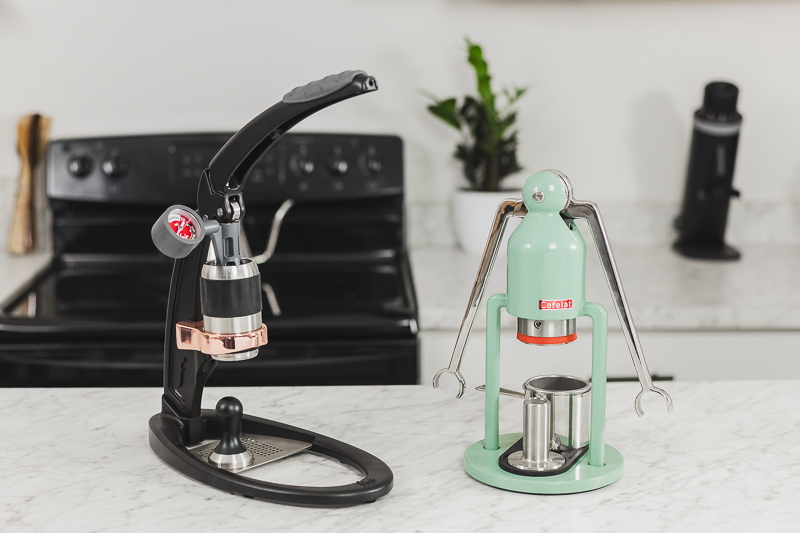 What is the perfect way to begin a journey? Baby steps. We learned that from Richard Dreyfus and Bill Murray in 1991. If you’re new to espresso and have been thinking about making some at home, manual machines are the quintessential baby step, the antithesis of the go big or go home philosophy that often results in once-used extravagances collecting dust in garages and in basements. These two machines—the Cafelat Robot and Flair Pro 2—provide great introductions to true espresso and its parameters (e.g., pressure) even though they are quite different. The Flair, for instance, being compact and travel-friendly, has small components, like a 46mm basket, tamper, and filter holder, that can be packed into its custom travel case. The Robot, on the other hand, being countertop stable, has a 58mm precision basket, tamper, and handled portafilter, which looks much like those on other machines, and weighs 7.5 lbs. because of its premium metal components. As for temperature stability, the Robot’s basket is the water chamber, so the water doesn’t have to travel through other pieces to reach the coffee; the Flair’s filter and water chamber, though, are separate bodies, so the water does have to travel through a separate channel to reach the coffee, losing some heat along the way. The Flair comes standard with a pressure gauge, but the base model Robot comes without one. Perhaps the most obvious difference, though, is in design: the Flair is modern (it even has a copper flair); the Robot is vintage (in shape and color options), a reference to the original manual espresso machines that used to grace kitchen counters in Italy. If you love the idea of a manual lever machine but just can't bear to heat water in a kettle, the first step for the Flair and the Robot (because they are completely manual), then you want the classic La Pavoni Europiccola.
What is the perfect way to begin a journey? Baby steps. We learned that from Richard Dreyfus and Bill Murray in 1991. If you’re new to espresso and have been thinking about making some at home, manual machines are the quintessential baby step, the antithesis of the go big or go home philosophy that often results in once-used extravagances collecting dust in garages and in basements. These two machines—the Cafelat Robot and Flair Pro 2—provide great introductions to true espresso and its parameters (e.g., pressure) even though they are quite different. The Flair, for instance, being compact and travel-friendly, has small components, like a 46mm basket, tamper, and filter holder, that can be packed into its custom travel case. The Robot, on the other hand, being countertop stable, has a 58mm precision basket, tamper, and handled portafilter, which looks much like those on other machines, and weighs 7.5 lbs. because of its premium metal components. As for temperature stability, the Robot’s basket is the water chamber, so the water doesn’t have to travel through other pieces to reach the coffee; the Flair’s filter and water chamber, though, are separate bodies, so the water does have to travel through a separate channel to reach the coffee, losing some heat along the way. The Flair comes standard with a pressure gauge, but the base model Robot comes without one. Perhaps the most obvious difference, though, is in design: the Flair is modern (it even has a copper flair); the Robot is vintage (in shape and color options), a reference to the original manual espresso machines that used to grace kitchen counters in Italy. If you love the idea of a manual lever machine but just can't bear to heat water in a kettle, the first step for the Flair and the Robot (because they are completely manual), then you want the classic La Pavoni Europiccola.
Anna or Silvia?
 You never thought this decision would come down to two given names that were popular in the late 19th century, but here you are. Both the Anna and the Silvia are single boiler machines under $1,000. Neither has a PID and both have a 3-way solenoid valve. The decision, then, comes down to the particulars. The aesthetic is similar: stainless steel cubes. The size is similar, too, with the Anna being slightly shorter (13") than the Silvia (13.7"). Same with performance: each of these entry-level machines brews true espresso at 9-bar and is capable at steaming microfoam, though the Silvia’s wand is objectively better at that job. The biggest question for this comparison is this: What is a millimeter worth to you? The Anna’s group and therefore portafilter is 57mm, one millimeter shy of those on the Silvia, which, at 58mm, is the industry standard. The benefits for brewing are minimal; the benefits for accessorizing are numerous. Think portafilters, distribution tools, tampers, and precision baskets. The Silvia is the clear choice if you want to buy a bunch of accessories and still be able to use them when you eventually—and everyone eventually does this—upgrade to a more capable espresso machine, which will surely have a 58mm group. The Anna is the clear choice if that scenario doesn’t appeal to you.
You never thought this decision would come down to two given names that were popular in the late 19th century, but here you are. Both the Anna and the Silvia are single boiler machines under $1,000. Neither has a PID and both have a 3-way solenoid valve. The decision, then, comes down to the particulars. The aesthetic is similar: stainless steel cubes. The size is similar, too, with the Anna being slightly shorter (13") than the Silvia (13.7"). Same with performance: each of these entry-level machines brews true espresso at 9-bar and is capable at steaming microfoam, though the Silvia’s wand is objectively better at that job. The biggest question for this comparison is this: What is a millimeter worth to you? The Anna’s group and therefore portafilter is 57mm, one millimeter shy of those on the Silvia, which, at 58mm, is the industry standard. The benefits for brewing are minimal; the benefits for accessorizing are numerous. Think portafilters, distribution tools, tampers, and precision baskets. The Silvia is the clear choice if you want to buy a bunch of accessories and still be able to use them when you eventually—and everyone eventually does this—upgrade to a more capable espresso machine, which will surely have a 58mm group. The Anna is the clear choice if that scenario doesn’t appeal to you.
Silvia Pro or Manus?
 The Rancilio Silvia Pro is basically a larger version of the Silvia M, with more features, especially for temperature stability, an extra boiler, and a switch for manually starting and stopping the brew. The Manus, on the other hand, is in many ways a classic heat-exchanger E-61 machine with the characteristic mushroom-cap grouphead and a lever for manually starting and stopping the brew. Both machines have a simple digital display flanked by two identical buttons—plus and minus—to adjust the PID, i.e., boiler temperatures. The Silvia Pro’s menu, unlike that of the Manus, goes beyond temperatures, and includes such conveniences as standby, wake-up, and automatic cleaning programs, making Pro slightly less manual than the Manus (which makes sense because “manus” is Latin for “hand”). The manual in the Manus applies to the temperature, too. Even though it has a PID and the brew temperature is generally quite stable, it is still a heat-exchanger machine, which requires you to flush the superheated water from the lines before pulling a shot. Beyond that, the choice comes down to style. The Manus is the clear choice if you want a vintage (circa 1961) look and have a little more headroom under your cabinets; and the Silvia Pro is the clear choice if you want a stainless steel machine with sharp lines that will blend in with other appliances in any contemporary kitchen (in other words, a 2021 look).
The Rancilio Silvia Pro is basically a larger version of the Silvia M, with more features, especially for temperature stability, an extra boiler, and a switch for manually starting and stopping the brew. The Manus, on the other hand, is in many ways a classic heat-exchanger E-61 machine with the characteristic mushroom-cap grouphead and a lever for manually starting and stopping the brew. Both machines have a simple digital display flanked by two identical buttons—plus and minus—to adjust the PID, i.e., boiler temperatures. The Silvia Pro’s menu, unlike that of the Manus, goes beyond temperatures, and includes such conveniences as standby, wake-up, and automatic cleaning programs, making Pro slightly less manual than the Manus (which makes sense because “manus” is Latin for “hand”). The manual in the Manus applies to the temperature, too. Even though it has a PID and the brew temperature is generally quite stable, it is still a heat-exchanger machine, which requires you to flush the superheated water from the lines before pulling a shot. Beyond that, the choice comes down to style. The Manus is the clear choice if you want a vintage (circa 1961) look and have a little more headroom under your cabinets; and the Silvia Pro is the clear choice if you want a stainless steel machine with sharp lines that will blend in with other appliances in any contemporary kitchen (in other words, a 2021 look).
Bianca or Zarre?
 As with the previous comparison, this one is a collision of the old and new worlds of espresso. The Bianca has an E-61 design despite being a dual boiler machine (not a heat-exchanger single boiler like its E-61 pal, the Manus). Lelit chose this style because it offers the easiest way to install a paddle and a pressure gauge above the grouphead, giving you full control over the flow of the shot in real time and allowing you to experiment with different pre-infusion, bloom, and extraction flows. Further, in the control center, you can set an automatic preinfusion in addition to boiler temperatures and other parameters. The dual-boiler Zarre, on the other hand, is a pressure profiling machine with the capability to program shots by time. Using a dial on the external controller, you can adjust the pressure of the shot in real time. If you’d rather not think about it, though, you can use that same controller to adjust parameters, such as boiler temperatures, or—and this is a big advantage for the Zarre—to program shots by volume. The Bianca is a semi-automatic machine with the option of flow control, then, whereas the Zarre is a hybrid—program shots by time, use the semi-automatic (read start/stop) operation, or dabble in pressure profiling. This difference is reflected in the price—the Zarre is several hundred dollars more than the Bianca. Both machines can be plumbed in and both come with wood accents—the Bianca with walnut knobs, legs, paddle, lever, and portafilter handle; the Zarre, again, with your choice of walnut, maple, or black side panels, portafilter handles, and knobs. This decision will likely come down to pressure vs. flow. The Bianca is the clear choice if you want to experiment with flow; and the Zarre is the clear choice if you want to experiment with pressure but have the option to program shots, an especially useful option in a busy home.
As with the previous comparison, this one is a collision of the old and new worlds of espresso. The Bianca has an E-61 design despite being a dual boiler machine (not a heat-exchanger single boiler like its E-61 pal, the Manus). Lelit chose this style because it offers the easiest way to install a paddle and a pressure gauge above the grouphead, giving you full control over the flow of the shot in real time and allowing you to experiment with different pre-infusion, bloom, and extraction flows. Further, in the control center, you can set an automatic preinfusion in addition to boiler temperatures and other parameters. The dual-boiler Zarre, on the other hand, is a pressure profiling machine with the capability to program shots by time. Using a dial on the external controller, you can adjust the pressure of the shot in real time. If you’d rather not think about it, though, you can use that same controller to adjust parameters, such as boiler temperatures, or—and this is a big advantage for the Zarre—to program shots by volume. The Bianca is a semi-automatic machine with the option of flow control, then, whereas the Zarre is a hybrid—program shots by time, use the semi-automatic (read start/stop) operation, or dabble in pressure profiling. This difference is reflected in the price—the Zarre is several hundred dollars more than the Bianca. Both machines can be plumbed in and both come with wood accents—the Bianca with walnut knobs, legs, paddle, lever, and portafilter handle; the Zarre, again, with your choice of walnut, maple, or black side panels, portafilter handles, and knobs. This decision will likely come down to pressure vs. flow. The Bianca is the clear choice if you want to experiment with flow; and the Zarre is the clear choice if you want to experiment with pressure but have the option to program shots, an especially useful option in a busy home.
Linea Mini or Eagle One Prima?
 The Linea Mini is a nod to the original Linea—first released in the 1990s—which is predictably a little boxy and imposing on the counter. But hey, that’s the 90s. The Eagle One Prima, on the other hand, is a nod to its cool, slightly elder siblings, the White and Black Eagle, which were designed and released just a few years ago, and has been heavily endorsed by YouTube coffee personality James Hoffman. The Linea looks heavy and is (71 lbs.). The Prima looks light, like it is readying to fly off, but isn’t (81 lbs.). On the inside, though, these machines have been outfitted with the latest technology from their manufacturer, including apps where all the details live. This is good because neither has a true display. The Linea Mini has a paddle that is the on/off switch for brewing. The Prima has a ghost display that shows numbers only when the temperature is heating or during a shot when it is temporarily a timer. Otherwise, it vanishes into the grouphead. More than likely, though, you will set and view parameters in the apps. Both have tremendous temperature stability with PIDs—at this price, every machine does—but the Linea Mini’s temperature is adjusted by an analog wheel or in the app whereas the Prima’s is adjusted only within the app. Perhaps the starkest difference, though, is in volumetrics. The Linea Mini is semi-automatic. The Prima, on the other hand, can be operated manually (semi-automatic) but also has the option to program shots by volume, making it a likelier choice for commercial (e.g., catering or coffee cart) applications. The Prima is the clear choice if you have a fast-pace small business and/or appreciate modern design and convenience (in the volumetrics); and the Linea Mini is the clear choice if you appreciate classic design and don't mind being present for the entire shot (because it's semi-automatic). That latter point makes the Prima a little more practical for commercial enterprises, though the Linea Mini is surely capable.
The Linea Mini is a nod to the original Linea—first released in the 1990s—which is predictably a little boxy and imposing on the counter. But hey, that’s the 90s. The Eagle One Prima, on the other hand, is a nod to its cool, slightly elder siblings, the White and Black Eagle, which were designed and released just a few years ago, and has been heavily endorsed by YouTube coffee personality James Hoffman. The Linea looks heavy and is (71 lbs.). The Prima looks light, like it is readying to fly off, but isn’t (81 lbs.). On the inside, though, these machines have been outfitted with the latest technology from their manufacturer, including apps where all the details live. This is good because neither has a true display. The Linea Mini has a paddle that is the on/off switch for brewing. The Prima has a ghost display that shows numbers only when the temperature is heating or during a shot when it is temporarily a timer. Otherwise, it vanishes into the grouphead. More than likely, though, you will set and view parameters in the apps. Both have tremendous temperature stability with PIDs—at this price, every machine does—but the Linea Mini’s temperature is adjusted by an analog wheel or in the app whereas the Prima’s is adjusted only within the app. Perhaps the starkest difference, though, is in volumetrics. The Linea Mini is semi-automatic. The Prima, on the other hand, can be operated manually (semi-automatic) but also has the option to program shots by volume, making it a likelier choice for commercial (e.g., catering or coffee cart) applications. The Prima is the clear choice if you have a fast-pace small business and/or appreciate modern design and convenience (in the volumetrics); and the Linea Mini is the clear choice if you appreciate classic design and don't mind being present for the entire shot (because it's semi-automatic). That latter point makes the Prima a little more practical for commercial enterprises, though the Linea Mini is surely capable.
Final Thoughts
So? What did you decide? Have you picked your machine? If not, have you at least narrowed it down? Or—and this is not our intention but we recognize the possibility nonetheless—do you feel overwhelmed? If overwhelmed, reach out. We'd love to talk you through the process. We have a team on hand for that very thing. If you want to read a tiny bit more information before clicking "add to cart," then head on over to our home espresso hub. And if you are now eagerly (and patiently, we know) awaiting the delivery of your Silvia Pro or Linea Mini or Robot (or whichever one you have chosen) to be packed up securely and delivered to your door, head on over to our learning center to read about making great espresso and steaming velvety milk. By the time your machine arrives, you will have arrived at the knowledge necessary—don't worry, it's not much, and we have some talented teachers here at Prima—to get the most out of your new espresso machine and yourself.
